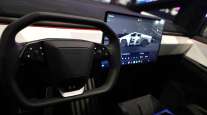Contributing Writer
Einride Readies US Test for Automated Podlike Truck

[Stay on top of transportation news: Get TTNews in your inbox.]
Einride, the Swedish autonomous truck startup, plans to expand its range of podlike self-driving trucks and launch a pilot program in the U.S. with tire manufacturer Bridgestone.
The company recently raised $10 million in a second round of funding and is investing the money into self-driving truck development. Einride is already testing its first-generation pod to haul goods autonomously between two warehouses for Swedish logistics provider DB Schenker.
Einride now plans to develop a series of so-called Autonomous Electric Transport vehicles, ranging from AET 1 to AET 4. Each will be designed for a specific type of freight use.
Witness the future of freight, starting now.https://t.co/r0WU12W4Bw — Einride (@einrideofficial) October 8, 2020
They all can haul about 16 tons but at different speeds and over various distances. The AET 1, for example, is a slow-speed vehicle designed for port and distribution center operations. It can drive up to about 20 mph and has a range of 80 miles to 110 miles. The AET 4 would be used for local freight. It will go up to about 55 mph over the same range. The other models fit in between.
“We can already see a strong traction from the market to start using autonomous and electric transport. The benefits are clear,” said Robert Falck, Einride’s founder and CEO.
Established truck manufacturers also are developing autonomous vehicles. Both Navistar and Traton, Volkswagen’s truck subsidiary, are partnering with San Diego-based self-driving startup TuSimple to build vehicles. Daimler is developing an autonomous Freightliner truck.
Einride’s approach is dramatically different; its vehicles look like something from a science fiction movie. They lack a cab, windows and mirrors, have no manual controls such as steering wheels and pedals, and their sculpted fronts are designed for aerodynamics. The company plans for the vehicle to travel autonomously, with the occasional intervention of a remote driver.

Falck
“Without a cab, the pod weighs less overall than a comparative electric truck, is more aerodynamic, and has more room for cargo on board. This translates to better range and load capacity than a truck designed for a human driver,” Falck told Transport Topics.
The remote operation negates the need for a human driver to be present at all times, which would reduce transport costs and improve utilization, he said.
The company also plans to take a different sales approach than traditional truck manufacturers, which rely on motor carriers and shipping companies for the bulk of their sales.
Einride’s business model would provide its AET pod as a service.
“You pay a monthly subscription fee for the turnkey solution of operating one or multiple pods, including the hardware, as well as access to the freight mobility platform for coordination and operation,” Falck said. In addition to the Bridgestone pilot, Einride is in “ongoing discussions with multiple U.S.-based companies about deploying pods in their transport network,” Falck said.
The company does not yet have a production contract, but said it is in talks with multiple potential manufacturers.
Want more news? Listen to today's daily briefing:
Subscribe: Apple Podcasts | Spotify | Amazon Alexa | Google Assistant | More




